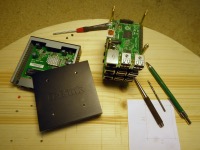Let Docker Swarm all over your Raspberry Pi Cluster
Fri, Jul 3, 2015In this blog post we show you how easy it is to install Swarm on your Raspberry Pi and how to set up a Raspberry Pi Swarm cluster with the help of Docker Machine.
We have built a little “Pi Tower” with three Raspberry Pi 2 model B and combined them into a Docker Swarm cluster.
As you can see in the pictures below we have mounted the three Raspberry Pi’s on top of a 5-port D-Link GBit switch. All four devices get their power from an Anker 4-port USB charger. This makes a very solid but portable “Pi Tower” with only one power plug and one external network connector.




For your convenience we have prepared a small shopping list of all the components we used at Amazon.
Pre-requisites
For this tutorial we will run all steps from a Mac. To do this we need three tools.
- A flash tool to write the SD card images for all the Raspberry Pi’s.
- The Docker client, which is only a
brew install dockeraway. - The Docker Machine binary with the hypriot driver
Flash all SD cards
First we want to install the SD cards with Docker preinstalled. On a Mac or Linux machine we can use our little flash command line tool to prepare the three SD cards with these simple commands:
$ flash --hostname pi1 http://downloads.hypriot.com/hypriot-rpi-20150416-201537.img.zip
$ flash --hostname pi2 http://downloads.hypriot.com/hypriot-rpi-20150416-201537.img.zip
$ flash --hostname pi3 http://downloads.hypriot.com/hypriot-rpi-20150416-201537.img.zip
Now insert the SD cards into all Raspberry Pi’s and boot them. They will come up with different host names after a while.
Retrieve IP addresses
Our SD card image also starts the avahi-daemon to announce the hostname through mDNS, so each Pi is reachable with pi1.local, pi2.local and pi3.local.
Docker Machine cannot resolve these hostnames at the moment, so we have to retrieve the IP addresses for the Raspberry Pi’s manually.
$ ping -c 1 pi1.local
$ ping -c 1 pi2.local
$ ping -c 1 pi3.local
For this example we assume that the three IP adresses are 192.168.1.101, 102 and 103.
Insert SSH public key
Docker Machine connects to each Raspberry Pi through SSH. You have to insert your public SSH key to avoid entering the password of the root user.
To insert the SSH public key into a remote machine there is a tool called ssh-copy-id. You might have to install it first.
$ ssh-copy-id [email protected]
$ ssh-copy-id [email protected]
$ ssh-copy-id [email protected]
For each of the above commands you have to enter the password hypriot for the user root.
Create Docker Machines
For the next step we use our Docker Machine driver to connect to the Raspberry Pi Hypriot devices.
Our hypriot driver is not yet integrated into the official Docker Machine binary.
So we have to download the docker-machine binary with our hypriot machine driver.
$ curl -o docker-machine http://downloads.hypriot.com/docker-machine_0.4.0-dev_darwin-amd64
$ chmod +x ./docker-machine
Download the binary into the current directory and make it executable. You may move it into another directory in your PATH to use it from other directories.
Create Swarm Token
A Docker Swarm cluster uses a unique Cluster ID which allows the individual swarm agents to find each other. We need such a Cluster ID to build our Docker Swarm.
This can be done in your shell with
$ export TOKEN=$(for i in $(seq 1 32); do echo -n $(echo "obase=16; $(($RANDOM % 16))" | bc); done; echo)
$ echo $TOKEN
For this example we use
$ export TOKEN=babb1eb00bdecadedec0debabb1eb00b
If you already have a Docker swarm container up and running, you also can create a new Cluster ID
with docker run --rm hypriot/rpi-swarm create.
We simply used the shell commands above to skip this chicken or egg problem.
Create the Swarm Master
Now we create the Docker Swarm Master on the first Raspberry Pi with our generated Cluster ID
$ ./docker-machine create -d hypriot --swarm --swarm-master --swarm-discovery token://$TOKEN --hypriot-ip-address 192.168.1.101 pi1
This command connects to the Raspberry Pi “pi1”, secures the Docker daemon with TLS and pulls the Docker image hypriot/rpi-swarm:latest from the Docker Hub.
It starts both the Swarm Master as well as a Swarm Agent in a container.
To check if everything works we can connect to the newly started Swarm Master by using the following command. It retrieves all environment variables needed for the Docker client to communicate with the Swarm.
$ eval $(./docker-machine env --swarm pi1)
$ docker info
Containers: 2
Strategy: spread
Filters: affinity, health, constraint, port, dependency
Nodes: 1
pi1: 192.168.1.202:2376
└ Containers: 2
└ Reserved CPUs: 0 / 4
└ Reserved Memory: 0 B / 971.3 MiB
We now have successfully set up a lonely Swarm Manager. Let’s start some more Raspberry Pi’s to prevent the Swarm Manager from feeling lonely.
Create the Swarm agents
For the rest of the Raspberry Pi’s we also create Docker Machine connections with the same Cluster ID.
This time we run docker-machine without the --swarm-master option to just spin up a Swarm Agent container in each Pi.
$ ./docker-machine create -d hypriot --swarm --swarm-discovery token://$TOKEN --hypriot-ip-address 192.168.1.102 pi2
$ ./docker-machine create -d hypriot --swarm --swarm-discovery token://$TOKEN --hypriot-ip-address 192.168.1.103 pi3
Let’s check what the swarm looks like now
$ docker info
Containers: 4
Strategy: spread
Filters: affinity, health, constraint, port, dependency
Nodes: 3
pi1: 192.168.1.101:2376
└ Containers: 2
└ Reserved CPUs: 0 / 4
└ Reserved Memory: 0 B / 971.3 MiB
pi2: 192.168.1.102:2376
└ Containers: 1
└ Reserved CPUs: 0 / 4
└ Reserved Memory: 0 B / 971.3 MiB
pi3: 192.168.1.103:2376
└ Containers: 1
└ Reserved CPUs: 0 / 4
└ Reserved Memory: 0 B / 971.3 MiB
We also can list all containers in the whole swarm as usual with
$ docker ps
CONTAINER ID IMAGE COMMAND CREATED STATUS PORTS NAMES
5effaa7de4a3 hypriot/rpi-swarm:latest "/swarm join --addr 2 minutes ago Up About a minute 2375/tcp pi3/swarm-agent
6b73003b7246 hypriot/rpi-swarm:latest "/swarm join --addr 4 minutes ago Up 3 minutes 2375/tcp pi2/swarm-agent
5e00fbf7b9f6 hypriot/rpi-swarm:latest "/swarm join --addr 7 minutes ago Up 7 minutes 2375/tcp pi1/swarm-agent
02c905ec25a0 hypriot/rpi-swarm:latest "/swarm manage --tls 7 minutes ago Up 7 minutes 2375/tcp, 192.168.1.101:3376->3376/tcp pi1/swarm-agent-master
After setting up the Docker Swarm you now can use the normal Docker commands through port 3376. Have a look at the official Docker Swarm documentation for more details.
Just remember to set up the environment correctly to communicate with the Swarm Master before using the Docker client by
$ eval $(docker-machine env --swarm pi1)
And then you can remotely manage your Raspberry Pi Swarm from your Mac. See - this was not really difficult, was it?
We hope you enjoyed this little tour of Docker Swarm!
As always use the comments below to give us feedback and share it on Twitter or Facebook.
Stefan
comments powered by Disqus
 Edit this blog on GitHub
Edit this blog on GitHub